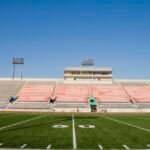- Last Updated -
Soccer's Attacking Midfielder And The Crucial Role It Plays
The attacking midfielder position also known as the number 10 position in soccer is a vital role that requires specific skills such as excellent field vision, ball control, and the ability to assist in the attack.
In this article, we will explore the different aspects of this position and its importance in modern soccer.

The Role of the Attacking Midfielder
The attacking midfielder is a midfielder whose primary role is to assist in the attack. They are responsible for creating chances for their team to score goals by providing accurate passes and shots on goal.
This position is crucial in modern soccer and is comparable to a quarterback in American football. The attacking midfielder needs to have excellent field vision, read the defense, and anticipate runs ahead of them. [3]
Key Skills of an Attacking Midfielder
The attacking midfielder requires specific skills to excel in their role. These skills include:
1. Excellent Field Vision
Attacking midfielders need to have excellent field vision to see plays and anticipate runs ahead of them. They must be able to read the game and understand their team’s attacking patterns. This skill allows them to provide accurate passes and create scoring opportunities for their team. [3]
2. Ball Control
Attacking midfielders need to be able to control the ball with speed and precision. This skill enables them to move the ball out of their feet and into space to maximize their chances of finding a successful pass.
They must be able to dribble out of trouble and outfox opponents to create scoring opportunities. [2]
3. Passing Accuracy
An attacking midfielder needs to have a high passing accuracy to provide accurate passes to their teammates. This skill enables them to create scoring opportunities and assist their teammates in scoring goals. The midfielder must be able to provide passes with speed and precision to ensure that their team maintains possession of the ball. [1]
4. Shooting Accuracy
Attacking midfielders must have the ability to shoot accurately from long and short distances. This skill enables them to score goals themselves and also provide scoring opportunities for their teammates.
They must be able to shoot accurately and with enough power to beat the goalkeeper. [5]
The Importance of the Attacking Midfielder in Soccer
The attacking midfielder position is crucial in modern soccer. This position is responsible for creating chances for their team to score goals. The following are the key reasons why the attacking midfielder is essential in soccer:
The attacking midfielder is a crucial position in soccer, and they are responsible for orchestrating the team’s attack.
This player is typically positioned behind the forwards and in front of the central midfielders, and their primary responsibility is to create and score goals. Here are the top reasons why the attacking midfielder is so important in soccer:
1. Playmaking:
The attacking midfielder is responsible for creating scoring opportunities for the team. They are often the most creative players on the field and have excellent field vision to see plays and anticipate runs ahead of them [2].
2. Goal-scoring:
Attacking midfielders are often capable of scoring goals themselves. They have the ability to take players on at speed in the final third, link up with the striker, create goal-scoring opportunities for other players, apply pressure on the opponent’s backline, and finish clinically [4].
3. Ball Retention:
The attacking midfielder is responsible for keeping the ball and maintaining possession in the final third. They have excellent dribbling skills, which allow them to move the ball quickly and shut off their opponent’s defense [3].
4. Linking up the team:
Attacking midfielders link up the midfield and the attack, often operating in the areas between the central midfielder and center forward. They are relied upon to look for and receive the ball, control and pass it with confidence, and always aim to move up the pitch and create chances for their team [5].
5. Dictating Tempo:
Attacking midfielders are expected to control and dictate the tempo of the game. They can slow down the game to hold onto a lead or speed up the game to make a comeback [6].
6. Defensive Contributions:
While primarily an attacking position, the attacking midfielder must also contribute defensively, especially when the opposition is counter-attacking. They must help defend and disrupt the opponent’s midfield and break up their attacking moves [1].
the attacking midfielder is a crucial position in soccer, responsible for creating and scoring goals, maintaining possession, linking up the team, dictating the tempo, and contributing defensively.
Their importance cannot be overstated, and the success of a team often hinges on the effectiveness of their attacking midfielder.
Attacking Midfielder Number 10 on the field
The attacking midfielder position in soccer is often associated with the number 10 on the field, and it is considered a critical role in a team’s offensive strategy.
While there is no clear consensus on the origin of the number 10 being assigned to the attacking midfielder position, there are some theories and historical references that provide insight into the matter.
One theory suggests that the number 10 was assigned to the attacking midfielder position because it was traditionally the number worn by the team’s best player, who was of

ten a creative playmaker or a goal-scoring threat [1].
Another theory suggests that the number 10 was assigned to the attacking midfielder position as a result of the 2-3-5 formation that was popular in the early days of soccer, where the attacking midfielder was the center forward and wore the number 10 jersey [2].
Regardless of the origin, the number 10 has become synonymous with the attacking midfielder position, and some of the best players in soccer history have worn this number, including Diego Maradona, Lionel Messi, Zinedine Zidane, and Ronaldinho [1].
The attacking midfielder’s primary responsibility is to assist in the attack, and they must have excellent field vision, playmaking ability, and goal-scoring instincts to be effective in this role [2]. The attacking midfielder position is highly coveted and remains an essential part of a team’s offensive strategy in modern soccer.
The origin of the number 10 being assigned to the attacking midfielder position in soccer is not entirely clear, but it is believed to be associated with the role’s historical importance as a creative playmaker and goal-scoring threat.
Regardless of its origins, the number 10 has become synonymous with the attacking midfielder position, and some of the best players in soccer history have worn this number.
The attacking midfielder position remains a critical role in modern soccer, requiring a combination of excellent field vision, playmaking ability, and goal-scoring instincts to be effective.

FAQs
What is the difference between an attacking midfielder and a central midfielder?
Attacking midfielders focus on creating chances and assists for the strikers, while central midfielders focus on controlling the pace of the game and transitioning the team from defense to attack.
What skills should an attacking midfielder have?
An attacking midfielder should have excellent ball control, field vision, passing skills, shooting skills, and the ability to dribble out of trouble.
What is the role of an attacking midfielder in a soccer team?
The role of an attacking midfielder is to create chances and assists for the strikers, control the pace of the game, and help the team transition from defense to attack.
How can an attacking midfielder improve their skills?
An attacking midfielder can improve their skills by practicing their ball control, passing, shooting, and dribbling regularly. They should also work on their fitness and conditioning to keep up with the pace of the game.
Can an attacking midfielder also defend?
Yes, an attacking midfielder is also responsible for helping the team defend and make recovery runs. They should be willing to track back and help their team defend when needed.
What is the number of an attacking midfielder?
Traditionally, attacking midfielders were number 8 in the team. However, modern soccer has changed things a little bit, and they are now number 10s.
What is the difference between a shadow striker and a traditional striker?
A shadow striker plays in a free role behind the striker/s and acts as a playmaker, while a traditional striker’s primary role is to score goals.
Can a central midfielder play as an attacking midfielder?
Yes, a central midfielder can play as an attacking midfielder if they have the necessary skills and qualities required for the position.
What is the importance of an attacking midfielder in a soccer team?
An attacking midfielder is crucial in a soccer team as they are responsible for creating chances and assists for the strikers, controlling the pace of the game, and helping the team transition from defense to attack.
Who is the best attacking midfielder in soccer?
There have been many great attacking midfielders in soccer history, such as Zinedine Zidane, Lionel Messi, Andres Iniesta, and Kevin De Bruyne, to name a few.
Conclusion
The role of an attacking midfielder in soccer is crucial to the team’s success. They are responsible for creating chances and assists for the strikers, controlling the pace of the game, and helping the team transition from defense to attack.
An attacking midfielder should possess excellent ball control, field vision, passing skills, shooting skills, and the ability to dribble out of trouble.
By improving these skills and working on their fitness and conditioning, an attacking midfielder can become a valuable asset to their team.
Box-to-Box Center Midfielder: The Engine of Modern Soccer Teams
Soccer is a game of skill, strategy, and teamwork. Every player has...
Read MoreHow To Be A Good Soccer Parent! A Guide to Sideline Etiquette
What Makes A Good Soccer Parent? As a soccer parent, you have...
Read More



















